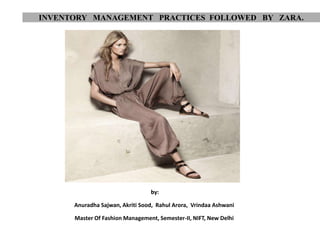
Zara Inventory Management
- 1. INVENTORY MANAGEMENT PRACTICES FOLLOWED BY ZARA.
- 2. Introduction Zara was launched in 1975 as a local store, "Zara" is now the world's third largest clothing retailer. The company, Inditex, has two dozen manufacturing plants in Spain and more than 1,160 stores in 34 countries from the United States to Japan. Zara developed a business model that incorporated the following three goals for operations: Develop a system the requires short lead times, Decrease quantities produced to decrease inventory risk Increase the number of available styles and/or choice. Thus, combining moderate prices with the ability to offer new clothing styles faster than its competitors.
- 3. ZARA’S BUSINESS MODEL Zara’s business model can be broken down into three basic components: Concept: To maintain design, production, and distribution processes that will enable Zara to respond quickly to shifts in consumer demands. Capabilities: It maintains tight control over their production processes keeping design and manufacturing in-house or with some strategic partnerships located nearby . They have strategic agreements with local manufacturers that ensure timely delivery and service. Thus, maintaining the flexibility necessary to design and produce over 12000 new items annually.
- 4. 3. Value drivers : for Zara are both tangible and intangible in the benefits that are returned to all stakeholders. Tangibly Inditex, the parent company of Zara, has 11.02% net margin on operations. Intangibly, customer loyalty and brand recognition have provided significant value to Zara.
- 7. 50% of the products Zara sells are manufactured in Spain, 26% in the rest of Europe, and 24% in Asian and African countries and the rest of the world. The company can design a new product and have finished goods in its stores in four to five weeks It can modify existing items in as little as two weeks. Shortening the product life cycle means greater success in meeting consumer preferences. Zara maintains a design team of 200 people, all of which produce approximately 12,000 new styles per year for Zara.
- 14. Key features in the inventory management practises Zara, unlike its competitors such as Gap, Benetton, and H&M, does not use Asian outsourcing. Eighty percent of Zara’s materials are manufactured in Europe, with 50% made in Zara controlled facilities in the Galicia region of Spain near headquarters. The local strategic partnerships that Zara maintains with manufacturers in Europe allow for a product throughput time of 3-4 weeks from conception to distribution. To make this happen, the company designs and cuts its fabric in-house and it acquires fabrics in only four colors to keep costs low. Zara postpones dyeing and printing designs until close to manufacture, thereby reducing waste and minimizing the need to clear unsold inventories.
- 16. Key features in the inventory & competitive advantages: The proximity of these suppliers gives Zara great flexibility in adapting their product lines based on up to date market trends and consumer behaviour. It also decreases costs of holding inventory. Zara’s competitors, through outsourcing to Asian countries such as China, sacrifice the benefits of proximity for low labour and production costs.
- 17. Though there is a cost advantage in their approach in regards to labor, the lack of flexibility in changing orders based on current trends hinders their operational efficiencies. Inventory costs are higher for competitors because orders are placed for a whole season well in advance and then held in distribution facilities until periodic shipment to stores. This proximity effect and the flexibility that it gives Zara is fundamental to their basic concept to respond quickly to shifts in consumer demand and has provided them with a competitive edge in comparison to their peers.
- 18. Competitive edge Zara has competitive advantage especially in the areas of product development, strategic partnerships and cost of production, advertising and marketing, and information technology infrastructure.
- 19. References http://www.zara.com/ www.3isite.com/articles/ImagesFashion_Zara_Part_I.pdf www.3isite.com/articles/ImagesFashion_Zara_Part_II.pdf http://hbswk.hbs.edu/archive/4652.html Harvard Business Review, Vol. 82, No.11, November 2004 http://en.wikipedia.org/wiki/Fast_fashion http://www.torex.com/english/news/whitepapers/pdf/FastFashion-en-WP.pdf
- 20. THANK YOU